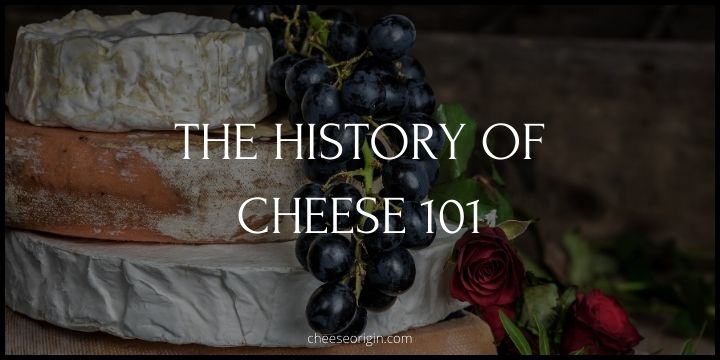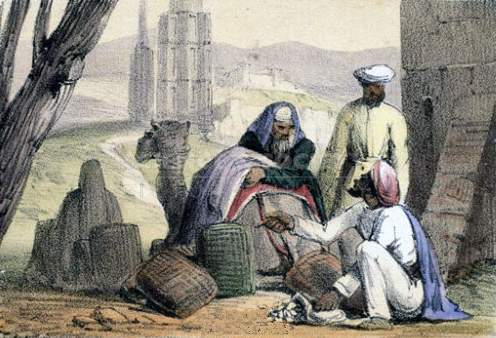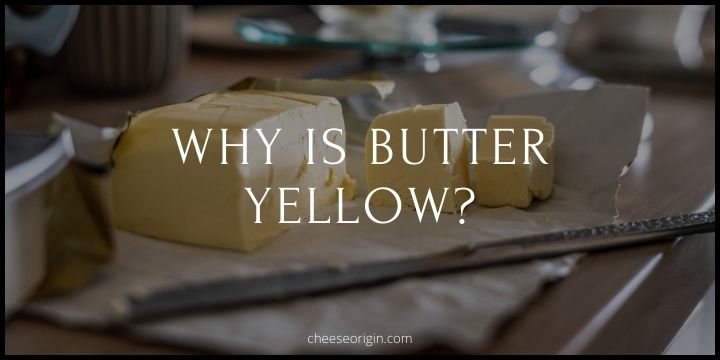The History of Cheese 101 (TIMELINE AND FACTS)

The discovery of cheese by our ancestors is by accident (albeit a happy one) since there was no science back then.
Any milk left to warm by a fire or stored in a sack made from the stomach of an animal would have soured, causing the milk solids (the curds) and liquid (the whey) to coagulate and separate, allowing a man to learn that his most precious commodity, milk, could be preserved in the form of cheese, and eventually, that rennet, an enzyme found in the stomach of the milk-producing animal, was the coagulant.
The Legend Of The First Cheeses

According to legend, an Arab shepherd carrying a sheep’s flask full of milk had to walk home beneath the scorching desert sun. When he got home he realized his milk had solidified.
In other words, the milk has curdled and cheese was born.
Other stories abound and whoever ‘invented’ cheese or wherever it ‘originated’ is pretty much still a mystery.
A Summary of Cheese History (BC Era)
| YEAR (BC) | Summary |
|---|---|
| 8500 BC: | Goats were the first livestock to be domesticated by early humans during the Neolithic Revolution. |
| 7000 BC: | Cattle are domesticated in Western Anatolia (modern-day Turkey). |
| 6500 BC: | People start to turn to milking sheep, cows, and goats as a food source. |
| 5000 BC: | About twenty different cheeses were recorded at these times. |
| 4500 BC: | Cheesemaking culture has taken hold across Europe, in the Mediterranean, and through Western Asia down to India. |
| 3000 BC: | Faisselles (straining molds) have been discovered in Greece and Sicily. |
| 2000 BC: | The Hittites include a friendly fight with cheese as part of the entertainment at one of their religious festivals. |
| 150 BC: | The Romans produced the earliest recorded smoked cheese, with the best wheels found in Velabrum. |
Cheese History Timeline (BC – Before Christ Era)
8500 BC
Goats in the Fertile Crescent were the first livestock to be domesticated by humans early in the Neolithic Revolution. However, they were initially raised for meat and fiber, not milk.
7000 BC
Cattle were first domesticated in Western Anatolia (modern-day Turkey).
6500 BC
After generations of livestock breeding and domestication – coupled with a population explosion in the Levant that depleted resources – people turn to milking sheep, cows, and goats as a food source that utilizes grazing lands not suited for crops. Around the same time, pottery-making techniques are developed thereby allowing humans to store milk, ferment it, and drain off whey. This development opened up the possibility of cheesemaking.
5000 BC
Mesopotamian mosaics dating to 5000 BC and Sumerian documents dating to 3000 BC show the existence of about twenty different cheeses at these times. (Source)
4500 BC
By the time 4500 BC arrived, the cheesemaking culture that originated in the Fertile Crescent has taken hold across Europe, in the Mediterranean, and through Western Asia down to India.
3000 BC
Faisselles (straining molds) have been discovered in Greece and Sicily.
2000 BC
The Hittites in central Anatolia included a fight with cheeses – as weapons, not opponents – as part of the entertainment at one of their religious festivals.
150 BC
The Romans produced the earliest recorded smoked cheese, with the best wheels found in, and named for, the Velabrum, the city’s bustling food marketplace.
A Summary of Cheese History (AD Era)
| YEAR | SUMMARY |
|---|---|
| 774: | Brie de Meaux earned an important fan: the emperor Charlemagne, who placed regular orders for the iconic cheese. |
| 1135: | The first appearance of the word formaticus, would later become fromage (French for cheese today). |
| 1184: | Gouda, a cheese that would become synonymous with the Netherlands, enters the historical record. |
| Late 13th Century: | The earliest record of a macaroni-and-cheese type dish appears – it was called the de lasanis (which sounded awfully similar to lasagna). |
| 1585: | The first cheeses are produced in Mexico, using sheep’s milk. |
| 1623: | The first dairy cows arrived in the U.S. |
| 1831: | French inventor Nicolas Appert discovered the process called ‘appertisation,’ a precursor to pasteurization. |
| 1854: | A discovery by Louis Pasteur that yeasts are responsible for fermentation and heating milk could halt microbial activity without damaging flavor and quality. |
| 1919: | The well-known Cabot Creamery is founded in Vermont |
| 1937: | Kraft Dinner’s first mac-and-cheese box made its debut in the U.S. |
| 1964: | The United States got its first taste of Swiss fondue at The New York World’s Fair. |
| 1970s to 1980s: | Powerful women pioneer a new era in American cheesemaking (find out more below). |
| 2018: | The world’s oldest cheese was discovered in the tomb of Ptahmes. It’s 3,200 years old. |
Cheese History Timeline (AD – Anno Domini or the Common Era)
Year 774
Cheese had a major breakthrough in 774. Brie de Meaux, produced on farmsteads around Abbaye du Jouare outside Paris, earns an important fan: the emperor Charlemagne, who placed regular orders for the iconic soft-ripened cheese.
Year 1135
The first appearance in writings of the word formaticus, would become fourmage (fourteenth century), fromaige (fifteenth century), and finally fromage (French for cheese today).
Year 1184
Gouda, a cheese that would become synonymous with the Netherlands in the seventeenth century, first enters the historical record.
Late 13th Century
The earliest record of a macaroni-and-cheese type dish appears in the anonymously authored Neapolitan cookbook Liber de Coquina, the dish was called de lasanis (which sounds awfully similar to lasagna) according to the writer Clifford A. Wright. The dish consists of boiled squares of fermented pasta dough tossed with grated cheese.
1585
Following Spanish colonization, the first cheeses were produced in Mexico, using sheep’s milk.
1623
The first dairy cows arrived in what is now the United States of America, brought along with East Anglian colonizers to Plymouth Colony.
1831
French inventor Nicolas Appert discovered the process called ‘appertisation,’ a precursor to pasteurization. The process of heating milk in an airtight container makes it easier to preserve.
1854
A big discovery by French Biologist, Louis Pasteur, uncovers that yeasts are responsible for fermentation and that heating products like wine, beer, and milk could halt microbial activity without damaging flavor and quality.
1919
Cabot Creamery, the farmer-owned New England dairy famed for its cheddar, was founded in Vermont.
1937
Kraft Dinner’s first mac-and-cheese boxed product consisting of noodles with a package of grated cheese attached made its debut in the United States.
1964
The United States was introduced to Swiss fondue at The New York World’s Fair – the tradition of enjoying crusty bread dipped in warm, luscious melted Alpine cheese.
1970s to 1980s
Powerful women like Judy Schad (Capriole), Mary Keene (Cypress Grove), Alison Hooper (Vermont Butter and Cheese), and Laura Chenel (Laura Chenel’s Chèvre) pioneered a new era in American cheesemaking.
2018
The world’s oldest cheese (that is around 3,200 years old) was discovered by Archaeologists from the University of Catania and the University of Cairo in the tomb of Ptahmes (the tomb of an Egyptian high-ranking official).
Conclusion
These are the facts and timeline of the history of cheese in a nutshell. This page will be consistently updated to keep up with the latest breakthroughs in the world of cheese.
Thanks for reading.
Check out our previous post: 35 Words Every Cheese Lover Should Know (TERMS)
The timeline on this post was mostly derived from Stuff Every Cheese Lover Should Know by Alexandra Jones. It is a small book that I’d highly recommend every cheese lover and connoisseur to have.





